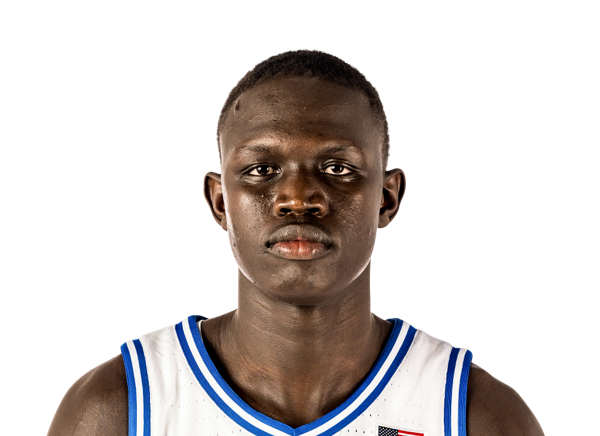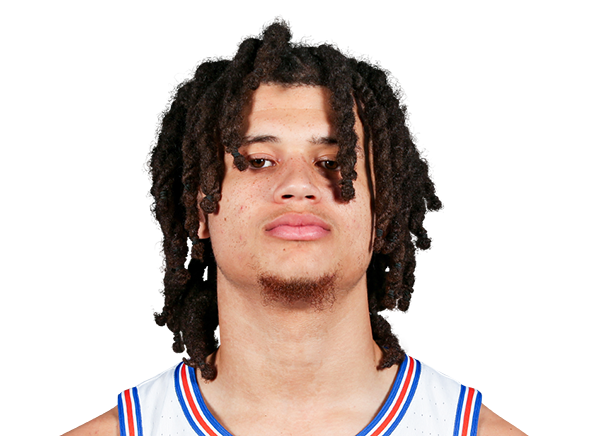Full Analysis
Offense
Khaman Maluach offers a tantalizing athletic profile: a massive frame with elite vertical reach, impressive mobility for his size, and a 9'6" standing reach that places him in rarified air among NBA bigs. On paper, he projects as a prototypical modern lob threat and play finisher, and in his role at Duke, he filled that assignment efficiently, converting a blistering 84% of his half-court shots at the rim and dunking 80 times in 39 games.
In practice, however, the offensive package is extremely narrow. Maluach is a limited on-ball player with questionable hands, poor feel as a passer, and minimal comfort when forced to make decisions outside of his finishing window. He rarely makes advanced reads, doesn’t facilitate out of short rolls or post touches, and had just five total assists in 289 minutes against Power Conference competition. That 4.3 AST% is quite low among first-round center prospects and suggests a significant feel gap that modern NBA offenses are increasingly unwilling to accommodate.
His hands, while capable of finishing clean lobs, are not consistent in traffic or when catching difficult passes on the move. He tends to bobble or fumble when pressured, which limits his utility in quick-execution plays like short rolls, dump-offs, or post seals. While he does show soft touch on layups and tip-ins, his ability to handle ball pressure or finish through crowds remains unrefined.
Shooting remains a theoretical component of his game. Maluach attempted only 16 threes this season, making four (25%). His mechanics are functional but slow, and he rushes shots under minimal contest. The better touch indicators come from the free throw line (75.4%), and he did shoot reasonably well in international contexts (31.6% on threes in BAL), but the volume and confidence aren't there yet. His overall offensive profile remains play-finisher-only, with little in the way of scalability or improvisation.
There’s also untapped potential in his rim-running and transition play,areas where his speed and long strides should shine, but Duke didn’t lean into that usage much, and his transition volume was oddly low for a big with his tools. A more spaced NBA floor might unlock more there, but the development curve will require patience.
Defense
Defensively, Maluach has immense upside as a rim protector and mobility-based big, but his reputation has at times outpaced his actual production. He averaged 1.3 blocks per game (6.8 BLK%), a respectable but not elite figure for someone of his size and tools. Part of the explanation lies in Duke's scheme, where Maluach often played higher up on screens, and his responsibilities included hedging or switching, but the lack of eye-popping stocks does matter.
His switchability is more theoretical than proven. Maluach can slide his feet reasonably well for a 7-footer and has the length to recover when beaten, but he’s not a true “scheme-proof” big. He’ll overcommit on switches, misread angles, and get blown by when playing too close to smaller guards. At times, he closes off his own recovery lanes due to poor positioning or footwork. His hands are rarely active in passing lanes, and he does not make consistent use of his wingspan to disrupt pocket passes or cross-court looks.
Interior defense is more stable. He understands how to wall up and remove shooting angles without leaving his feet. His size alone deters drives, and he’s developed more discipline compared to his earlier tape. But he’s not a dominant vertical rim protector and doesn’t impose the same fear factor around the rim as peers like Donovan Clingan or Walker Kessler did in college. In key matchups, especially against physical or skilled frontcourts like Houston and Kansas, he struggled to assert himself, sometimes disappearing entirely on the glass.
And that leads to the most pressing concern: his rebounding. Maluach’s numbers on the offensive boards are strong (2.7 OREB/G), but his overall presence as a rebounder is streaky. He doesn’t always come down with contested boards, gets knocked off position too easily, and can be disengaged after the initial effort. His zero-rebound performance in 20 minutes against Houston’s bruising frontcourt was emblematic of the concern. He has the tools to be a much better rebounder, but the instincts, physicality, and hand strength need real work.
Looking Ahead
Khaman Maluach is a tools-first prospect in the purest sense. He runs the floor well, jumps high, blocks some shots, and finishes lobs with elite efficiency. And at just 18 years old, with only a few years of formal basketball experience, he’s already contributing to high-level competition at Duke. The bet here is on continued rapid development, and to Maluach’s credit, his year-to-year improvement has been impressive.
But there are meaningful concerns about the shape of his NBA role. His lack of feel, limited processing speed, and rudimentary skill set on offense create real questions about how involved he can be beyond dunker spot duties. He doesn’t pass, doesn’t shoot, and doesn’t screen with much consistency. And while his defensive versatility gets touted, he’s more reactive than anticipatory, and doesn’t yet command the paint like a true anchor.
For teams needing a traditional rim runner who can develop behind a starting center, Maluach makes sense in the late lottery. He could absolutely become a rotation big, maybe even a low-usage starter if the jumper improves or the defense scales up. But for all the talk of upside, the pathway to realizing it is steep, and the floor is closer to a limited, scheme-dependent reserve than a foundational big.
He’s long, mobile, and improving. But in a league that increasingly demands decision-making, passing, and versatility from its bigs, Maluach still feels a step behind.



